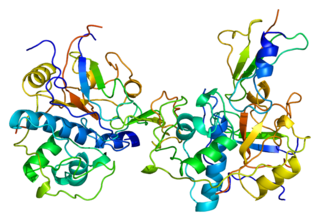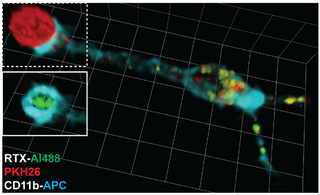Related Research Articles

A DNA vaccine is a type of vaccine that transfects a specific antigen-coding DNA sequence into the cells of an organism as a mechanism to induce an immune response.

In immunology, an immunological synapse is the interface between an antigen-presenting cell or target cell and a lymphocyte such as a T cell, B cell, or natural killer cell. The interface was originally named after the neuronal synapse, with which it shares the main structural pattern. An immunological synapse consists of molecules involved in T cell activation, which compose typical patterns—activation clusters. Immunological synapses are the subject of much ongoing research.

HLA-C belongs to the MHC class I heavy chain receptors. The C receptor is a heterodimer consisting of a HLA-C mature gene product and β2-microglobulin. The mature C chain is anchored in the membrane. MHC Class I molecules, like HLA-C, are expressed in nearly all cells, and present small peptides to the immune system which surveys for non-self peptides.

The Cluster of differentiation 80 is a B7, type I membrane protein in the immunoglobulin superfamily, with an extracellular immunoglobulin constant-like domain and a variable-like domain required for receptor binding. It is closely related to CD86, another B7 protein (B7-2), and often works in tandem. Both CD80 and CD86 interact with costimulatory receptors CD28, CTLA-4 (CD152) and the p75 neurotrophin receptor.

CD94, also known as killer cell lectin-like receptor subfamily D, member 1 (KLRD1) is a human gene.
In immunology, an adjuvant is a substance that increases or modulates the immune response to a vaccine. The word "adjuvant" comes from the Latin word adiuvare, meaning to help or aid. "An immunologic adjuvant is defined as any substance that acts to accelerate, prolong, or enhance antigen-specific immune responses when used in combination with specific vaccine antigens."
CD16, also known as FcγRIII, is a cluster of differentiation molecule found on the surface of natural killer cells, neutrophils, monocytes, macrophages, and certain T cells. CD16 has been identified as Fc receptors FcγRIIIa (CD16a) and FcγRIIIb (CD16b), which participate in signal transduction. The most well-researched membrane receptor implicated in triggering lysis by NK cells, CD16 is a molecule of the immunoglobulin superfamily (IgSF) involved in antibody-dependent cellular cytotoxicity (ADCC). It can be used to isolate populations of specific immune cells through fluorescent-activated cell sorting (FACS) or magnetic-activated cell sorting, using antibodies directed towards CD16.

Sir Leszek Krzysztof Borysiewicz is a British professor, immunologist and scientific administrator. He served as the 345th Vice-Chancellor of the University of Cambridge, his term of office started on 1 October 2010 and ended on 1 October 2017. Borysiewicz also served as chief executive of the Medical Research Council of the UK from 2007-2010 and was the chairman of Cancer Research UK from 2016 to 2023.

HLA class II histocompatibility antigen gamma chain also known as HLA-DR antigens-associated invariant chain or CD74, is a protein that in humans is encoded by the CD74 gene. The invariant chain is a polypeptide which plays a critical role in antigen presentation. It is involved in the formation and transport of MHC class II peptide complexes for the generation of CD4+ T cell responses. The cell surface form of the invariant chain is known as CD74. CD74 is a cell surface receptor for the cytokine macrophage migration inhibitory factor (MIF).

CD244 also known as 2B4 or SLAMF4 is a protein that in humans is encoded by the CD244 gene.

Killer cell immunoglobulin-like receptor 2DL1 is a protein that in humans is encoded by the KIR2DL1 gene.

NKG2-C type II integral membrane protein or NKG2C is a protein that in humans is encoded by the KLRC2 gene. It is also known as or cluster of differentiation 159c (CD159c).
The following outline is provided as an overview of and topical guide to immunology:

A tunneling nanotube(TNT) or membrane nanotube is a term that has been applied to cytoskeletal protrusions that extend from the plasma membrane which enable different animal cells to connect over long distances, sometimes over 100 μm between certain types of cells. Tunneling nanotubes that are less than 0.7 micrometers in diameter, have an actin structure and carry portions of plasma membrane between cells in both directions. Larger TNTs (>0.7 μm) contain an actin structure with microtubules and/or intermediate filaments, and can carry components such as vesicles and organelles between cells, including whole mitochondria. The diameter of TNTs ranges from 0.05 μm to 1.5 μm and they can reach lengths of several cell diameters. There have been two types of observed TNTs: open ended and closed ended. Open ended TNTs connect the cytoplasm of two cells. Closed ended TNTs do not have continuous cytoplasm as there is a gap junction cap that only allows small molecules and ions to flow between cells. These structures have shown involvement in cell-to-cell communication, transfer of nucleic acids such as mRNA and miRNA between cells in culture or in a tissue, and the spread of pathogens or toxins such as HIV and prions. TNTs have observed lifetimes ranging from a few minutes up to several hours, and several proteins have been implicated in their formation and inhibition, including many that interact with Arp2/3.

Trogocytosis is when a cell nibbles another cell. It is a process whereby lymphocytes conjugated to antigen-presenting cells extract surface molecules from these cells and express them on their own surface. The molecular reorganization occurring at the interface between the lymphocyte and the antigen-presenting cell during conjugation is also called "immunological synapse".
Immune stimulating complexes (ISCOMs) are spherical open cage-like structures (typically 40 nm in diameter) that are spontaneously formed when mixing together cholesterol, phospholipids and Quillaja saponins under a specific stoichiometry. The complex displays immune stimulating properties and is thus mainly used as a vaccine adjuvant in order to induce a stronger immune response and longer protection. A specific adjuvant based on ISCOM technology is Matrix-M.
Gillian Griffiths, FMedSci FRS is a British cell biologist and immunologist. Griffiths was one of the first to show that immune cells have specialised mechanisms of secretion, and identified proteins and mechanisms that control cytotoxic T lymphocyte secretion. Griffiths is Professor of Cell Biology and Immunology at the University of Cambridge and is the Director of the Cambridge Institute for Medical Research.

Mark Morris Davis is an American immunologist. He is the director of and Avery Family Professor of Immunology at the Institute for Immunity, Transplantation and Infection at Stanford University.

The Compatibility Gene is a 2013 book about the discovery of the mechanism of compatibility in the human immune system by the English professor of immunology, Daniel M. Davis. It describes the history of immunology with the discovery of the principle of graft rejection by Peter Medawar in the 1950s, and the way the body distinguishes self from not-self via natural killer cells. The compatibility mechanism contributes also to the success of pregnancy by helping the placenta to form, and may play a role in mate selection.

Sir Andrew James McMichael, is an immunologist, Professor of Molecular Medicine, and previously Director of the Weatherall Institute of Molecular Medicine at the University of Oxford. He is particularly known for his work on T cell responses to viral infections such as influenza and HIV.
References
- ↑ "Professor Daniel Davis". Imperial College London. October 5, 2006. Retrieved September 16, 2022.
- ↑ "Daniel M Davis, University of Manchester".
- ↑ Infarinato, Nicole (2018). "Dan Davis: Up close and personal with immune cells". Journal of Cell Biology. 217 (9): 2975–2976. doi:10.1083/jcb.201808060. PMC 6122991 . PMID 30108126.
- ↑ "Daniel M. Davis" (PDF). University of Manchester. Archived from the original (PDF) on 6 March 2017. Retrieved 5 March 2017.
- ↑ "Professor Daniel Davis". Imperial College. Retrieved 5 March 2017.
- ↑ "Focus on Natural Killer Cells: Classics". Nature Immunology. 9 (5). 2008.
- ↑ "Fellow Professor Daniel Davis". The Academy of Medical Sciences. Archived from the original on 21 April 2019. Retrieved 5 March 2017.
- ↑ "Daniel M Davis at Th Hay Festival".
- ↑ "Daniel M Davis Live at Latitude Festival".
- ↑ "Daniel M Davis and Robin Ince at How To Academy".
- ↑ "Dexamethasone: the coronavirus drug 91 years in the making".
- ↑ "The recipe for a breakthrough".
- ↑ "The big idea: how much do we really want to know about our genes?".
- ↑ "Professor Daniel Davis".
- ↑ "Engineered immunity: Redesigning antibodies to better fight disease".
- ↑ "Vaccines are about to become a lot more personalised (and effective)".
- ↑ "Intrigue at the immune synapse".
- ↑ "Professor Daniel Davis on The Infinite Monkey Cage".
- ↑ "Professor Daniel Davis on The Infinite Monkey Cage, What have we learnt from COVID".
- ↑ Davis DM, Chiu I, Fassett M, Cohen GB, Mandelboim O, Strominger JL (Dec 1999). "The human natural killer cell immune synapse". Proc Natl Acad Sci U S A. 96 (26): 15062–7. Bibcode:1999PNAS...9615062D. doi: 10.1073/pnas.96.26.15062 . PMC 24773 . PMID 10611338.
- ↑ Davis DM, Sowinski S (June 2008). "Membrane nanotubes: dynamic long-distance connections between animal cells". Nat. Rev. Mol. Cell Biol. 9 (6): 431–6. doi:10.1038/nrm2399. PMID 18431401. S2CID 8136865.